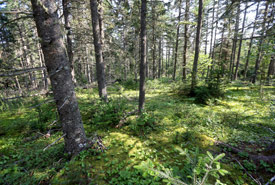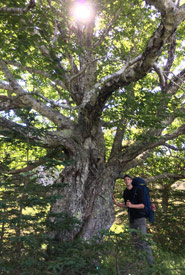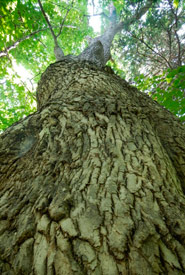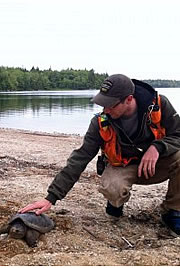A walk in the woods: Acadian old-growth forest

Acadian forest, Chignecto Isthmus, NS (Photo by Mike Dembeck)
If you’re at all like me, coming across big, old trees while exploring the woods is always a thrill. Over the past four years, as conservation biologist with the Nature Conservancy of Canada’s (NCC’s) Atlantic Region, I’ve walked across tens of thousands of hectares of land. So I know first-hand how rare those encounters really are.
When I do get the privilege of finding a behemoth, a sense of child-like awe washes over me at each encounter. I ponder to myself: just how old is it? What sort of wildlife might this tree have supported over the years? Did woodland caribou forage on its hanging lichens? Did the eastern wolf or cougar ever stop for a rest beneath its shady canopy? No doubt they did.

Blog author Josh Noseworthy (Photo by Richelle Martin)
Many trees of the Acadian forest region can live well over 400 years, and in that time would have supported many generations of wildlife. It can be hard to grasp that timescale. The imagination can run wild thinking back on the history that those trees would have witnessed.
I doubt I’ll ever lose that sense of awe, but the experience of finding big trees can also be a bittersweet one; a reminder of how precious those encounters are. The reality is that less than one per cent of old-growth Acadian forest remains in Maritime Canada, and that number is shrinking.
There has been a long history of European settlement on the east coast. With settlement came land clearing for agriculture, extensive logging and both accidental and intentional fires. Because there is very little of these old-growth forests left, very few people living in the region have ever walked through them or even know of their existence.
From historical records, we know that before land clearing and logging, the whole Maritime region was dominated by centuries-old, shade-loving trees such as red spruce, eastern hemlock, sugar maple, yellow birch and beech. In fact, more than 40 species of tree grow in the Acadian forest, making it one of the most diverse forest regions in North America.
In addition to the species mentioned above, there were also trees that were short-lived and preferred big, open space with lots of sunlight. These trees were adapted to life in the boreal forest, and could only be found in very restricted areas of the Acadian region, such as mountaintops, boggy wetlands and coastal areas.

White ash (Photo by Josh Noseworthy)
As land was cleared by early settlers, the wide-open spaces provided the perfect conditions for those boreal trees to colonize. Now, four centuries later, we have a superabundance of those trees across the landscape at the expense of our natural, shade-loving forest. In the conservation world, we call this process borealization, and it continues to this very day.
The good news is that old-growth Acadian forest still exists in the Maritimes. What’s more, borealization is both preventable and reversible! NCC is tackling this issue on both ends — by searching out and protecting remnant old-growth Acadian forest, and by restoring Acadian forest on lands that have been degraded.
Our projects range from reverting industrial conifer plantations back to native, mixed-species forests in southwest Nova Scotia, to reforesting abandoned farmland back to a rare coastal red oak woodland in southeast New Brunswick. We are also in the process of publishing a book to provide woodlot owners, land trusts and managers of protected areas with the knowledge to restore Acadian forest on their own lands.
As exciting as it is to find those big, old trees when wandering in the woods, I find it equally as exciting to be contributing to the future of old-growth in my home region. NCC shares a vision with many others to create a network of large, connected tracts of healthy Acadian forest, which supports healthy populations of the wildlife that depend on it. Together, we can restore the natural heritage of the Maritimes to its former glory once again.


